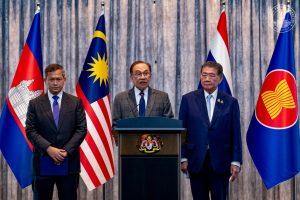Malaysia has a decent track record in international mediation, having successfully facilitated the 2014 Bangsamoro peace agreement, brokered the recent ceasefires between Thailand and Cambodia, and taken part in ongoing mediation efforts in Southern Thailand. It has also advocated a stronger ASEAN response to Myanmar’s crisis. But Malaysia is not realizing its full potential to mediate international disputes, and the country’s reliance on government-to-government diplomacy limits its capacity and effectiveness.
Malaysia’s recent bilateral mediation efforts have shown mixed results. Its recent diplomatic success with the Cambodia-Thailand ceasefire addressed symptoms rather than the underlying tensions, while its mediation efforts in the Southern Thailand insurgency have stalled. The Malaysian government successfully led mediation for the Bangsamoro peace agreement in the Philippines, which ended the 40-year conflict and created the Bangsamoro Autonomous Region in Muslim Mindanao. Despite Malaysia’s vocal criticism of Myanmar’s junta, ASEAN’s Five-Point Consensus has had limited success, and Malaysia has struggled to move beyond this stalled framework as ASEAN chair in 2025. These successes and setbacks show that while government-to-government approaches may be effective, they underestimate how multi-stakeholder engagement can de-securitize conflicts and contribute to more durable outcomes.
Malaysia’s chairmanship of ASEAN this year has demonstrated both the potential and limitations of traditional diplomatic approaches. The swift resolution of the Thailand-Cambodia border conflict in late July marked what observers called “a turning point in ASEAN diplomacy” by moving from ceremonial hosting to operational problem-solving. Prime Minister Anwar Ibrahim’s personal mediation – bringing both countries’ leaders to Putrajaya and establishing ASEAN observer teams to monitor the ceasefire – showed how Malaysia could embed monitoring within ASEAN structures rather than rely on external powers. Yet this success also demonstrated the constraints of government-to-government diplomacy: the ceasefire addressed the immediate violence but did not resolve the underlying disputes between Cambodia and Thailand.
ASEAN’s limitations in addressing complex conflicts like those in Myanmar call for including more stakeholders like ethnic armed organizations in peace processes. Yet as the case of Myanmar shows, conflicts often involve transnational networks, non-state actors, and economic interests that governments alone cannot address. The Myanmar situation illustrates how the junta can dismiss or ignore ASEAN’s official statements, while resistance groups, civil society organizations, and business networks continue to shape the trajectory of the conflict.
The stakes extend beyond any single conflict. As international competition intensifies, middle powers like Malaysia face a growing pressure to choose sides. Building mediation capacity allows Malaysia to play a role as a trusted facilitator rather than a dependent partner, maintaining strategic autonomy as global competition intensifies. With conflicts spanning from Myanmar to the Middle East, demand for credible mediation is significant. Malaysia has the opportunity to build credibility and offer alternatives to complement other approaches, where ASEAN is questioned and traditional mediators face trust deficits. Malaysia’s understanding of regional cultures, Southeast Asian strategic positioning, and non-aligned tendencies provide access to conflicts where other mediators face credibility challenges.
The case of Norway provides an example of mediation through multistakeholder engagement. The Oslo Channel that produced the 1993 Israeli-Palestinian accords did not emerge from the Foreign Ministry in Oslo. It started with Norwegian academics who had built relationships with both sides over years of unofficial dialogue. Norway’s Peace Research Institute provided analytical support, civil society organizations offered neutral venues, and business leaders offered economic incentives. The government’s role was crucial but not central.
Malaysia has comparable assets that are not strategically organized. The country’s experience managing ethnic and religious diversity domestically offers insights that could prove invaluable in divided societies.
These resources remain largely untapped. While Malaysia has commercial mediation centers, research centers and community dispute resolution facilities, it lacks dedicated institutes and networks to contribute to the resolution complex international conflict mediation and peace-building.
Regional trends suggest growing openness to multistakeholder mediation. Thailand is considering multistakeholder mediation processes for Myanmar, including ethnic organizations and armed groups – the kind of inclusive approach that traditional ASEAN mechanisms have resisted.
As its chairmanship comes to an end, Malaysia has the opportunity to reframe its approach. Rather than relying solely on government-to-government diplomacy, Malaysia could build the mediation ecosystem to address regional and international disputes. This means developing institutions that can engage with multiple stakeholders: government officials, civil society organizations, business networks, and communities. Such an ecosystem would also transcend political changes, sustaining mediation efforts despite changes in government. A multi-layered, multi-stakeholder approach will enable Malaysia to operate simultaneously at different scales.
Building this capacity requires building on existing strengths. The country could establish a national peace institute that combines research, training, and operational support for mediation efforts, and coordinates diverse actors while maintaining independence from singular interests. Universities could develop conflict resolution programs that train both Malaysian and international participants. The government could create fellowship programs that bring conflict practitioners to Malaysia while training Malaysians on international best practices.
The timing is strategic. As Malaysia concludes its ASEAN chairmanship in October, it has demonstrated both mediation credibility through the Thailand-Cambodia success and awareness of traditional approaches’ limitations through ongoing regional challenges.
While Malaysia faces financial constraints compared to wealthier states, these may be managed given Malaysia’s existing diplomatic infrastructure and regional relationships. Unlike states that can offer large aid packages, Malaysia must rely more on convening power and cultural credibility. These limitations could become a strategic advantage if Malaysia positions itself as a mediator that designs appropriate peace processes despite its resource constraints.
A strategic and systematic approach is necessary, to build mediation infrastructure that operates simultaneously across multiple scales. This will facilitate engagement between government officials, civil society organizations, business networks, and diaspora communities while transcending political changes. This approach would build layered mediation capacity and connect with regional and global mediation networks. Such engagement can navigate competing claims to authority and legitimacy that constrain government-to-government approaches, enabling diverse actors to contribute to inclusive and sustainable peace.
As Malaysia’s ASEAN chairmanship concludes in October, the foundations laid in 2025 provide the basis for strengthening its mediation capacity through multistakeholder engagement into the future.




























